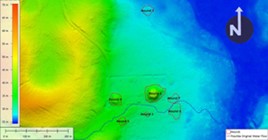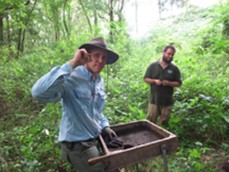Lake Jackson Mounds
Salvage excavations of a mound at Lake Jackson by Bureau of Archaeological Research (BAR) archaeologists in the 1970s uncovered elaborately decorated copper and shell items that bore Mississippian style artwork.
Mississippian sites feature distinctive earthen mound architecture, artwork and trade items that were exchanged across the Mississippian interaction network. Lake Jackson is the southernmost mound center associated with this network, which consisted of the peoples who participated in shared cultural and ritual a ctivities and exchanged Mississippian style objects. From around 1000–1550 A.D., Mississippian sites stretched from Wisconsin in the north to Oklahoma in the west and Lake Jackson in Florida to the south.
ctivities and exchanged Mississippian style objects. From around 1000–1550 A.D., Mississippian sites stretched from Wisconsin in the north to Oklahoma in the west and Lake Jackson in Florida to the south.

Investigations in 2014 at Lake Jackson Mounds State Park uncovered new information about this unique site. The research was a collaborative effort involving BAR archaeologists and scholars and students from Georgia State University, Texas State University, and Florida State University. This work used technologies, such as Ground Penetrating Radar (GPR), to gain new insights into the site without damaging the mounds. Using LiDAR data that allows researchers to clearly analyze the topological variations of the terrain, BAR archaeologists made the first detailed map of the mounds and surrounding area. GPR data provided information on the construction of the mounds and the presence of potential structures on and around the mounds. Ongoing research into the chronology of the site promises to shed light on the origins of Lake Jackson and the spread of the Mississippian interaction network into north Florida.
into north Florida.
Images
LiDAR generated map of the Lake Jackson Mounds (top left).
An illustration of the copper breastplate discovered by BAR Archaeologist Calvin Jones during the excavations in 1970 (top right)
BAR archaeologist, Dan Seinfeld discovering a projectile point (arrowhead) while shovel testing at Lake Jackson. The type of point found here was characteristic of the Mississippian period (lower right).

